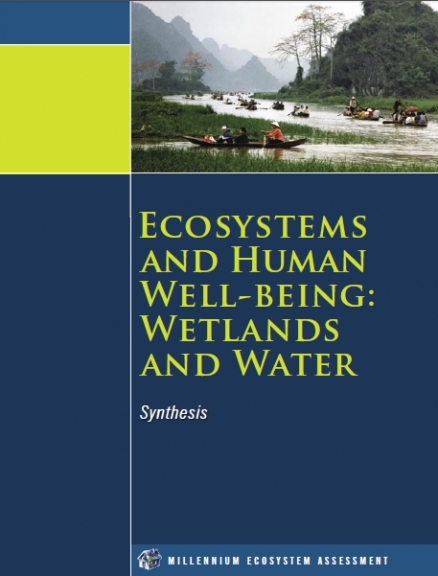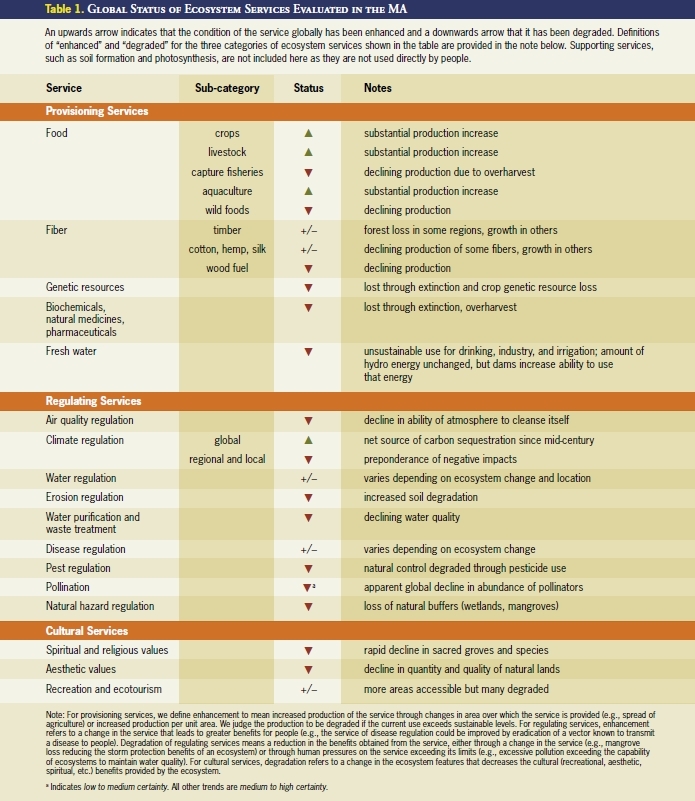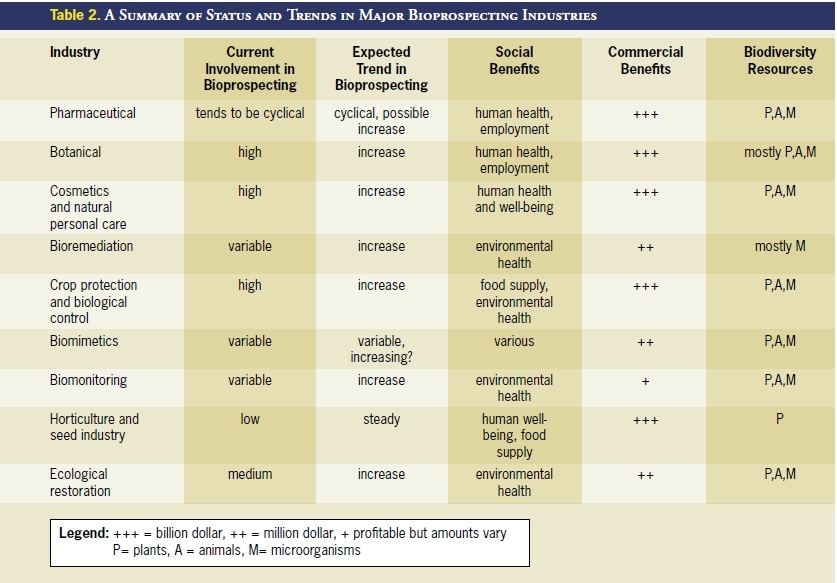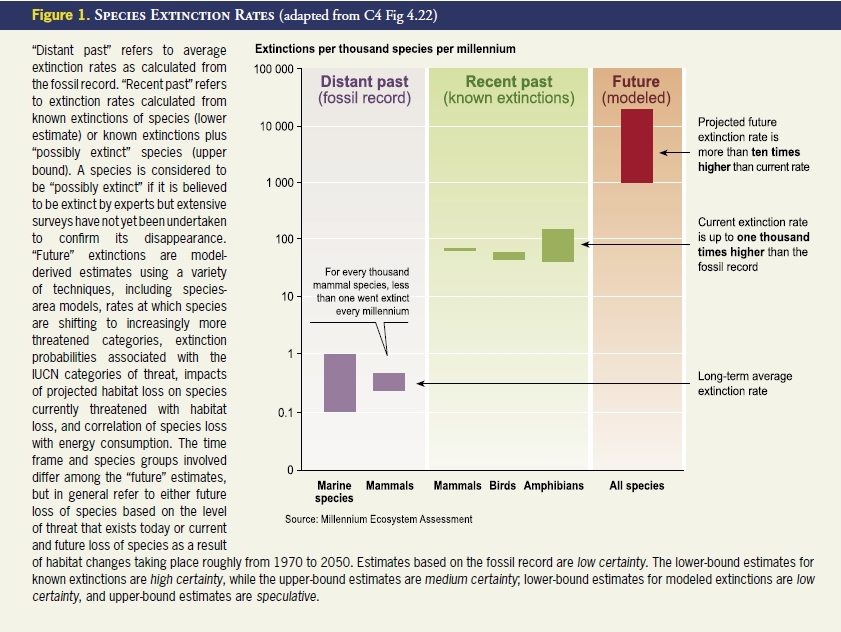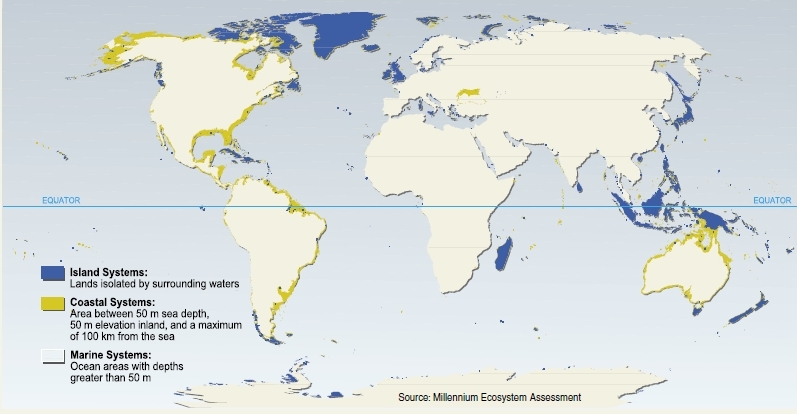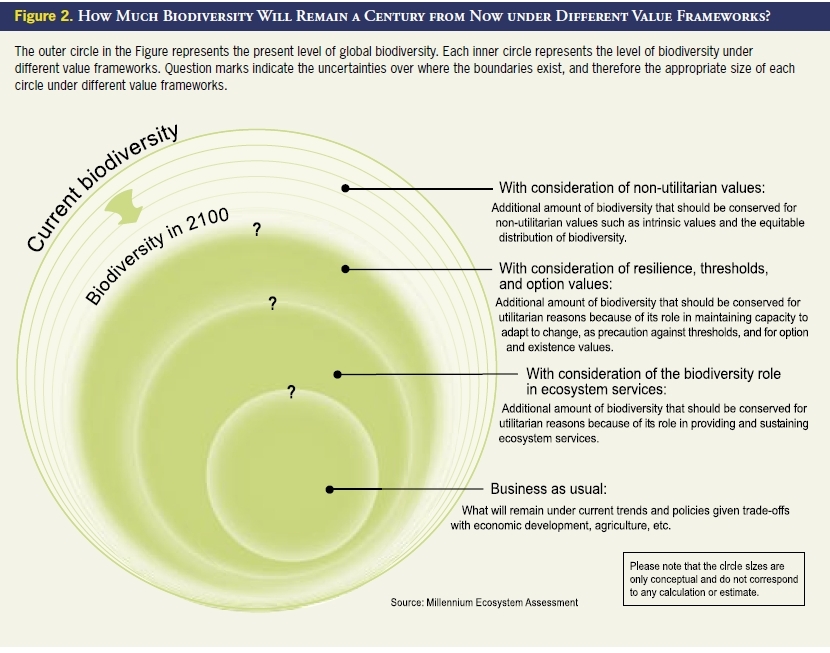Ecosystems and Human Well-being: Wetlands and Water: Summary for Decision-makers
This is part of the Millennium Ecosystem Assessment report Ecosystems and Human Well-being: Wetlands and Water.
Synthesis Team Co-chairs: C. Max Finlayson, Rebecca D’Cruz, Nick Davidson
Synthesis Team Members: Jacqueline Alder, Steve Cork, Rudolf de Groot, Christian Lévêque, G. Randy Milton, Garry Peterson, Dave Pritchard, Blake D. Ratner, Walter V. Reid, Carmen Revenga, María Rivera, Frederik Schutyser, Mark Siebentritt, Mishka Stuip, Rebecca Tharme
Contributing Authors: Stuart Butchart, Ellen Dieme-Amting, Habiba Gitay, Steve Raaymakers, Douglas Taylor
Extended Writing Team: MA Coordinating Lead Authors, Lead Authors, Contributing Authors, and Working Group Coordinators
Review Editors: José Sarukhán and Anne Whyte (Co-chairs) and MA Board of Review Editors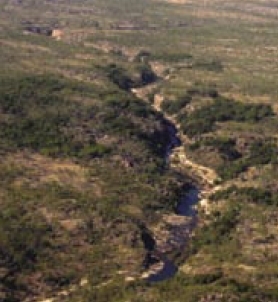
This report covers the range of wetlands as defined by the Ramsar Convention on Wetlands. These include inland wetlands (such as swamps, marshes, lakes, rivers, peatlands, and underground water habitats); coastal and near-shore marine wetlands (such as coral reefs, mangroves, seagrass beds, and estuaries); and human-made wetlands (such as rice fields (paddies), dams, reservoirs, and fish ponds).
For over 30 years, the Ramsar Convention has recognized the interdependence of people and their environment and is the only global intergovernmental convention addressing the interactions between water and wetland ecosystems. It has promoted the wise use of wetlands as a means of maintaining their “ecological character”— the ecosystem components and processes that comprise the wetland and that underpin the delivery of ecosystem services, such as fresh water and food.
Wetland Services and Human Well-being
Wetland ecosystems, including rivers, lakes, marshes, rice fields, and coastal areas, provide many services that contribute to human well-being and poverty alleviation. (See Table 1.) Some groups of people, particularly those living near wetlands, are highly dependent on these services and are directly harmed by their degradation. Two of the most important wetland ecosystem services affecting human well-being involve fish supply and water availability. Inland fisheries (Fisheries and aquaculture) are of particular importance in developing countries, and they are sometimes the primary source of animal protein to which rural communities have access. For example, people in Cambodia obtain about 60–80% of their total animal protein from the fishery in Tonle Sap and associated floodplains. Wetland-related fisheries also make important contributions to local and national economies. Capture fisheries in coastal waters alone contribute $34 billion to gross world product annually.
The principal supply of renewable fresh water for human use comes from an array of inland wetlands, including lakes, rivers, swamps, and shallow groundwater aquifers. Groundwater, often recharged through wetlands, plays an important role in water supply, with an estimated 1.5–3 billion people dependent on it as a source of drinking water. Rivers have been substantially modified around the world to increase the water available for human consumption. Recent estimates place the volume of water trapped behind (documented) dams at 6,000–7,000 cubic kilometers.
Other wetland services with strong linkages to human well-being include:
- Water purification and detoxification of wastes. Wetlands, and in particular marshes, play a major role in treating and detoxifying a variety of waste products. Some wetlands have been found to reduce the concentration of nitrate by more than 80%.
- Climate regulation. One of the most important roles of wetlands may be in the regulation of global climate change through sequestering and releasing a major proportion of fixed carbon in the biosphere. For example, although covering only an estimated 3–4% of the world’s land area, peatlands are estimated to hold 540 gigatons of carbon, representing about 1.5% of the total estimated global carbon storage and about 25–30% of that contained in terrestrial vegetation (Land-cover) and soils.
- Mitigation of climate change. Sea level rise and increases in storm surges associated with climate change will result in the erosion of shores and habitat, increased salinity of estuaries and freshwater aquifers, altered tidal ranges in rivers and bays, changes in sediment and nutrient transport, and increased coastal flooding and, in turn, could increase the vulnerability of some coastal populations. Wetlands, such as mangroves and floodplains, can play a critical role in the physical buffering of climate change impacts.
- Cultural services. Wetlands provide significant aesthetic, educational, cultural, and spiritual benefits, as well as a vast array of opportunities for recreation and tourism. Recreational fishing can generate considerable income: 35–45 million people take part in recreational fishing (inland and saltwater) in the United States, spending a total of $24–37 billion each year on their hobby. Much of the economic value of coral reefs—with net benefits estimated at nearly $30 billion each year—is generated from nature-based tourism, including scuba diving and snorkeling.
Wetlands provide many non-marketed and marketed benefits to people, and the total economic value of unconverted wetlands is often greater than converted wetlands (high certainty). There are many examples of the economic value of intact wetlands exceeding that of converted or otherwise altered wetlands. For instance, areas of intact mangroves in Thailand have a total net present economic value—calculated based on the economic contribution of both marketed products such as fish and non-marketed services such as protection from storm damage and carbon sequestration—of at least $1,000 per hectare (and possibly as high as $36,000 per hectare) compared with about $200 per hectare when converted to shrimp farms. In Canada, areas of intact freshwater marshes have a total economic value of about $5,800 per hectare compared with $2,400 when drained marshes are used for agriculture. This does not mean that conversion of wetlands is never economically justified, but it illustrates the fact that many of the economic and social benefits of wetlands have not been taken into account by decision-makers.
Both inland and coastal wetlands significantly influence the nature of the hydrological cycle and hence the supply of water for people and the many uses they make of water, such as for irrigation, energy, and transport. Changes in hydrology, in turn, affect wetlands.
- Wetlands deliver a wide array of hydrological services—for instance, swamps, lakes, and marshes assist with flood mitigation, promote groundwater recharge, and regulate river flows—but the nature and value of these services differs across wetland types.
- Flooding is a natural phenomenon that is important for maintaining the ecological functioning of wetlands (for example, by serving as a means for the natural transport of dissolved or suspended materials and nutrients into wetlands) and in particular for sustaining the delivery of many of the services they provide to millions of people, particularly to those whose livelihoods depend on floodplains for flood-recession agriculture and pasturage and for fish production.
- Many wetlands diminish the destructive nature of flooding, and the loss of these wetlands increases the risks of floods occurring. Wetlands, such as floodplains, lakes, and reservoirs, are the main providers of flood attenuation potential in inland water systems. Nearly 2 billion people live in areas of high flood risk—a risk that will be increased if wetlands are lost or degraded. Coastal wetlands, including coastal barrier islands, coastal river floodplains, and coastal vegetation (Land-cover), all play an important role in reducing the impacts of floodwaters produced by coastal storm events.
Physical and economic water scarcity and limited or reduced access to water are major challenges facing human society and are key factors limiting economic development in many countries. Water scarcity and declining access to fresh water are a globally significant and accelerating problem for 1–2 billion people worldwide, hindering growth in food production and harming human health and economic development.
The continued degradation of water quality will increase the prevalence of disease, especially for vulnerable people in developing countries, where technological fixes and alternatives are not readily available (high certainty). The burden of disease from inadequate water, sanitation, and hygiene totals 1.7 million deaths and results in the loss of at least 54 million healthy life years annually. Although largely eliminated in wealthier nations, water-related diseases (malarial and diarrheal diseases, for instance) are among the most common causes of illness and death in developing countries, affecting particularly the poor. Some waterborne chemical and microbiological pollutants also harm human health—sometimes, in the case of chemical pollutants, through biomagnification through the food chain. Water quality degradation also affects people indirectly by degrading the resource base on which they depend. Present institutional structures tend to promote a narrow, sectoral approach to intervention for individual diseases, providing little opportunity to consider broader approaches to ecosystem management as a tool for enhancing human health. Actions to overcome intersectoral divides would help promote the use of ecosystem assessments or eco-health approaches to address human health concerns.
Status and Trends of Wetlands
The global extent of wetlands is estimated to be in excess of 1,280 million hectares (1.2 million square kilometers) but it is well established that this is an underestimate. This estimate includes inland and coastal wetlands (including lakes, rivers, and marshes), near-shore marine areas (to a depth of 6 meters below low tide), and human-made wetlands such as reservoirs and rice fields and was derived from multiple information sources. However, these sources were known to under-represent many wetland types, and further data are required for some geographic regions.
More than 50% of specific types of wetlands in parts of North America, Europe, Australia, and New Zealand were converted during the twentieth century (medium to high certainty). Extrapolation of this estimate to wider geographic areas or to other wetland types, as has been done in some studies, is speculative only. For North America, the estimates refer to inland water and coastal marshes and emergent estuarine wetlands; the estimates for Europe include the loss of peatlands; those for Northern Australia are of freshwater marshes, while estimates for New Zealand are of inland and coastal marshes.
There is insufficient information on the extent of all wetland types being considered in this report—such as inland wetlands that are seasonally or intermittently flooded and some coastal wetlands—to document the extent of wetland loss globally. There is, however, ample evidence of the dramatic loss and degradation of many individual wetlands. For example, the surface area of the Mesopotamian marshes (located between the Tigris and Euphrates Rivers in southern Iraq) decreased from an area of 15,000–20,000 square kilometers in the 1950s to less than 400 square kilometers today due to excessive water withdrawals, dams, and industrial development. Similarly, the volume of water in the Aral Sea basin has been reduced by 75% since 1960 due mainly to large-scale upstream diversions of the Amu Darya and Syr Darya river flow for irrigation of close to 7 million hectares.
Coastal ecosystems are among the most productive yet highly threatened systems in the world. These ecosystems produce disproportionately more services relating to human well-being than most other systems, even those covering larger total areas, but are experiencing some of the most rapid degradation and loss:
- About 35% of mangroves (from countries with available multiyear data, representing 54% of total mangrove area at present) have been lost over the last two decades, driven primarily by aquaculture development, deforestation, and freshwater diversion.
- Some 20% of coral reefs were lost and more than a further 20% degraded in the last several decades of the twentieth century through overexploitation, destructive fishing practices, pollution (Water pollution) and siltation, and changes in storm frequency and intensity.
There is established but incomplete evidence that the changes being made are increasing the likelihood of nonlinear and potentially abrupt changes in ecosystems, with important consequences for human well-being. These nonlinear changes can be large in magnitude and difficult, expensive, or impossible to reverse. For example, once a threshold of nutrient loading is crossed, changes in freshwater and coastal ecosystems can be abrupt and extensive, creating harmful algal blooms (including blooms of toxic species) and sometimes leading to the formation of oxygen-depleted zones, killing all animal life. Capabilities for predicting some nonlinear changes are improving, but on the whole scientists cannot predict the thresholds at which change will be encountered. The increased likelihood of these nonlinear changes stems from the loss of biodiversity and growing pressures from multiple direct drivers of ecosystem change. The loss of species (Species diversity) and genetic diversity decreases the resilience of ecosystems —their ability to maintain particular ecosystem services as conditions change. In addition, growing pressures from drivers such as overharvesting, climate change, invasive species, and nutrient loading push ecosystems toward thresholds that they might otherwise not encounter.
Many wetland-dependent species in many parts of the world are in decline; the status of species dependent on inland waters and of waterbirds dependent on coastal wetlands is of particular concern. Although the evidence has geographical limitations and is chiefly from species already globally threatened with extinction, this pattern is consistent for different groups of species, with medium certainty in the underlying data. (See Table 2.) Between 1970 and 2000, populations of freshwater species included in the Living Planet Index declined on average by 50%, compared with 30% for marine and other terrestrial species (medium certainty). The status of globally threatened birds dependent on freshwater wetlands, and even more so that of coastal seabirds, has deteriorated faster since 1988 than the status of birds dependent on other (terrestrial) ecosystems.
Causes of Wetland Loss and Degradation
The primary indirect drivers of degradation and loss of rivers, lakes, freshwater marshes, and other inland wetlands (including loss of species or reductions of populations in these systems) have been population growth and increasing economic development. The primary direct drivers of degradation and loss include infrastructure development, land conversion, water withdrawal, pollution, overharvesting and overexploitation, and the introduction of invasive alien species. (See Figure 1.)
- Clearing and drainage, often for agricultural expansion, and increased withdrawal of fresh water are the main reasons for the loss and degradation of inland wetlands such as swamps,marshes, rivers, and associated floodplain water bodies. By 1985, an estimated 56−65% of inland and coastal marshes (including small lakes and ponds) had been drained for intensive agriculture in Europe and North America, 27% in Asia, 6% in South America, and 2% in Africa. The amount of water impounded behind dams quadrupled since 1960, and three to six times as much water is held in reservoirs as in natural rivers. Changes in flow regime, transport of sediments and chemical pollutants, modification of inland wetlands, and disturbance of migration routes have endangered many species and resulted in the loss of others.
- Agricultural systems and practices have exerted a wide range of mostly adverse impacts on inland and coastal wetlands globally. Both the extensive use of water for irrigation (some 70% of water use globally is for irrigation) and excessive nutrient loading associated with the use of nitrogen and phosphorus in fertilizers have resulted in a decline in the delivery of services such as fresh water and some fish species. On the other hand, the expansion of paddy rice cultivation has increased the area of human-made wetlands in some regions.
- The introduction of invasive alien species is now considered to be a major cause of local extinction of native freshwater species. Worldwide, two thirds of the freshwater species introduced into the tropics and more than half of those introduced to temperate regions have established self-sustaining populations.
The primary direct driver of the loss and degradation of coastal wetlands, including saltwater marshes, mangroves, seagrass meadows, and coral reefs, has been conversion to other land uses. Other direct drivers affecting coastal wetlands include diversion of freshwater flows, nitrogen loading, overharvesting, siltation, changes in water temperature, and species invasions. The primary indirect drivers of change have been the growth of human populations (Population growth rate) in coastal areas coupled with growing economic activity. Nearly half of the world’s major cities are located within 50 kilometers of the coast, and coastal population densities are 2.6 times larger than that of inland areas. This population pressure leads to conversion of coastal wetlands as a result of urban and suburban expansion and increasing agricultural demand (such as the clearing of mangroves for aquaculture). Given the extensive changes in land use and cover that have occurred in many coastal areas, it is unlikely that many of the observed changes in habitat and species loss will be readily reversed. Other important drivers of change in coastal wetlands include:
- Freshwater diversion from estuaries has meant significant losses in the delivery of water and sediment to nursery areas and fishing grounds in the [[coast]al zone] (high certainty) and to floodplains, affecting the livelihood of millions of people who depend on these coastal areas and floodplains for flood-recession agriculture and pasturage and for fish production and capture fisheries (Fisheries and aquaculture). Worldwide, although human activities have increased sediment flows in rivers by about 20%, reservoirs and water diversions prevent about 30% of sediments from reaching the oceans, resulting in a net reduction of sediment delivery to estuaries of roughly 10%.
- Seagrass ecosystems are damaged by a wide range of human impacts, including dredging and anchoring in seagrass meadows, coastal development, eutrophication, hyper-salinization resulting from reduction in freshwater inflows, siltation, habitat conversion for the purposes of algae farming, and climate change. Major losses of seagrass habitat have been reported from the Mediterranean, Florida Bay in the United States, and parts of Australia, and current losses are expected to accelerate, especially in Southeast Asia and the Caribbean.
- Disruption and fragmentation of coastal wetlands important as migration routes have endangered many species and resulted in the loss of others. For example, the decline of certain long-distance East Atlantic flyway populations (while other populations on the same flyway are stable or increasing) has been attributed to their high dependence on deteriorating critically important spring staging areas, notably the international Wadden Sea, that have been affected by commercial shellfisheries.
- Estuarine systems are among the most invaded ecosystems in the world, with introduced species causing major ecological changes. For example, San Francisco Bay in California has over 210 invasive species, with one new species established every 14 weeks between 1961 and 1995, brought in by ballast water of large ships or occurring as a result of fishing activities. The ecological consequences of the invasions include habitat loss and alteration, altered water flow and food webs, the creation of novel and unnatural habitats subsequently colonized by other invasive alien species, abnormally effective filtration of the water column, hybridization with native species, highly destructive predators, and introductions of pathogens and disease.
Excessive nutrient loading is expected to become a growing threat to rivers, lakes, marshes, [[coast]al zones], and coral reefs. Since 1950, nutrient loading—anthropogenic increases in nitrogen, phosphorus, sulfur, and other nutrient-associated pollutants— has emerged as one of the most important drivers of ecosystem change in freshwater and coastal ecosystems, and this driver is projected to substantially increase in the future (high certainty). Wetlands provide an important service by treating and detoxifying a variety of waste products, and some wetlands have been found to reduce the concentration of nitrate by more than 80% (C7.2.5, C12.2.3). However, excessive nutrient loading associated with the use of nitrogen and phosphorus in fertilizers has resulted in eutrophication (a process whereby excessive plant growth depletes oxygen in the water), acidification of freshwater (Freshwater biomes) and terrestrial ecosystems, large and at times toxic algal blooms, widescale deoxygentation (and hypoxia), and a decline in the delivery of services such as fresh water and some fish species.
The negative impacts of nutrient loading can extend hundreds of kilometers from the source of pollution (such as the creation of hypoxic “dead zones” in coastal areas). The flux of reactive (biologically available) nitrogen to the [[coast]s] and oceans increased by 80% from 1860 to 1990, with resulting eutrophication that has harmed coastal fisheries (Fisheries and aquaculture) and contributed to coral reef regime shifts that are effectively irreversible. Humans now produce more reactive (biologically available) nitrogen than is produced by all natural pathways combined, and some projections suggest that this may increase by roughly a further two thirds by 2050. Three out of four scenarios prepared during the MA project that the global flux of nitrogen to coastal ecosystems will increase by a further 10–20% by 2030 (medium certainty), with almost all of the increase occurring in developing countries.
Global climate change is expected to exacerbate the loss and degradation of many wetlands and the loss or decline of their species and to harm the human populations dependent on their services; however, projections about the extent of such loss and degradation or decline are not yet well established. Climate change is projected to lead to increased precipitation over more than half of Earth’s surface, and this will make more water available to society and ecosystems. However, increases in precipitation will not be universal, and climate change will also cause substantial decrease in precipitation in other areas.
Despite the benefits that increased precipitation may provide to some freshwater wetlands, the projected changes in climate are likely to have pronounced harmful impacts on many wetland ecosystems. Specifically:
- Many coastal wetlands will change as a consequence of projected sea level rise, increased storm and tidal surges, changes in storm intensity and frequency, and subsequent changes in river flow regimes and sediment transport. There will be adverse consequences for wetland species, especially those that cannot relocate to suitable habitats, as well as migratory species that rely on a variety of wetland types during their life cycle.
- Of all the world’s ecosystems, coral reefs may be the most vulnerable to the effects of climate change. Many coral reefs have undergone major, although often partially reversible, bleaching episodes when local sea surface [[temperature]s] have increased during one month by 0.5–1o Celsius above the average of the hottest month.
- Global climate change impacts will often exacerbate impacts of other drivers of degradation of wetlands. For example, decreased precipitation as a result of climate change will exacerbate problems associated with already growing demands for water. Higher sea surface temperatures will exacerbate threats to coral reefs associated with increased sedimentation. In limited cases, however, global climate change could lessen pressure on some wetlands, particularly in areas where precipitation increases.
- Specific adverse consequences of global climate change include already observed changes in the distribution of coastal wintering shorebirds in Western Europe associated with rising mid-winter temperatures. It is also anticipated that climate change will lead to population declines in high-Arctic breeding waterbird species as a result of habitat loss and that the distribution of many fish species will shift toward the poles, with coldwater fish being further restricted in their range, and cool- and warm-water fish expanding in range (medium certainty).
- The incidence of vector-borne diseases such as malaria and dengue and of waterborne diseases such as cholera is projected to increase in many regions (medium to high certainty).
There are a number of widely accepted reasons why many types of wetlands such as lakes, marshes, mangroves, tidal flats, and estuaries continue to be lost, converted, or degraded even though benefits gained from maintaining them often are greater than the benefits associated with their conversion:
- The individuals who benefit most from the conservation of wetlands are often local residents, including many who are likely to have been disenfranchised from decision-making processes. Decisions concerning the fate of wetlands, however, are often made through processes that are unsympathetic to local needs or that lack transparency and accountability.
- Decision-makers at many levels are unaware of the connection between wetland condition and the provision of wetland services and the consequent benefits for people. In very few instances are decisions informed by estimates of the total economic value of both the marketed and nonmarketed services provided by wetlands.
- Many services delivered by wetlands (such as flood mitigation, climate regulation, groundwater recharge, and prevention of erosion) are not marketed and accrue to society at large at local and global scales. More degradation of these “public goods” takes place than is in society’s interests. Individuals often do not have incentives to maintain the services for the benefit of wider society. Further, when an action results in the degradation of a service that harms other individuals, market mechanisms do not exist (nor, in many cases, could they exist) to ensure that these individuals are compensated for the damages they suffer.
- The private benefits of wetland conversion are often exaggerated by subsidies (Perverse subsidies) such as those that encourage the drainage of wetlands for agriculture or the large-scale replacement of coastal wetlands by intensive aquaculture or infrastructure, including for urban, industrial, and tourism development.
- In some cases, the benefits of conversion exceed those of maintaining the wetland, such as in prime agricultural areas or on the borders of growing urban areas. As more and more wetlands are lost, however, the relative value of the conservation of the remaining wetlands increases, and these situations become increasingly rare.
Scenarios for Wetlands
The MA developed four scenarios to explore plausible futures for ecosystems and human well-being. (See Box 1.) The scenarios explored two global development paths—one in which the world becomes increasingly globalized (Global Orchestration and TechnoGarden) and the other in which it becomes increasingly regionalized (Adapting Mosaic and Order from Strength)—as well as two different approaches to ecosystem management—one in which actions are reactive and most problems are addressed only after they become obvious (Global Orchestration and Order from Strength) and the other in which ecosystem management is proactive and policies deliberately seek to maintain ecosystem services for the long term (TechnoGarden and Adapting Mosaic).
The degradation of wetlands is expected to increase through 2050 under the reactive Global Orchestration and Order from Strength scenarios but to be relatively unchanged in 2050 (after initial increases in the early part of the century) under the proactive TechnoGarden and Adapting Mosaic scenarios. The degradation of wetlands is expected to increase (see Figure 2), and the global area of wetlands is expected to decrease with increases in human population, particularly in [[coast]al zones], and with the expansion of agricultural land. Toward 2050, there is a longterm increase of conversion to agricultural land use in the scenarios with reactive ecosystem management. For the proactive TechnoGarden and Adapting Mosaic scenarios, however, the development of technologies and skills for agroecosystem management could lead to restoration of wetlands. Furthermore, toward 2050 climate change begins to have significant impacts on coastal wetlands such as estuaries, tidal flats, and deltas as a result of sea level rise.
The demand for provisioning services, such as food, fiber, and water, strongly increases in all four scenarios due to expected growth in population and economies and changing consumption patterns (medium to high certainty). Land use change is expected to continue to be a major driver of changes in the provision of ecosystem services up to 2050 (medium to high certainty). A deterioration of the services provided by freshwater resources—aquatic habitat, fish production, and water supply for households, industry, and agriculture—is expected under the two scenarios that adopt reactive approaches to environmental problems (medium certainty). A less severe decline is expected under the other two scenarios, which proactively increase efficiency in resource use through environmental policies and an emphasis on the application of technology for environmental benefits. After 2050, climate change and its impacts (such as sea level rise) have an increasing effect on the provision of ecosystem services (medium certainty).
The demand for regulating services provided by wetlands, such as denitrification and protection against floods and storms, will increase, while the provision of these services is likely to decrease. The use of nitrogen and other fertilizers is projected to increase in all scenarios, raising the demand for nutrient removal by wetlands. There is likely to be increased pressure on wetlands, such as mangroves and floodplains, to buffer the physical impacts of extreme events, such as sea level rise and increases in storm surges.
Increased loss of wetlands will lead to global extinctions as species numbers approach equilibrium with the remnant habitat. It is likely under most scenarios that large, costly, and even irreversible environmental changes will become more common in the future unless offset by anticipatory management that deliberately maintains the resilience of wetlands. However, time lags between habitat reduction and species extinction may provide an opportunity for humans to reverse past losses and avoid future ones.
Major policy decisions in the next 50–100 years will have to address trade-offs among current uses of wetland resources and between current and future uses. Particularly important trade-offs involve those between agricultural production and water quality, land use and biodiversity, water use and aquatic biodiversity, and current water use for irrigation and future agricultural production. Under all the MA scenarios, resource management decisions tend to give highest priority to increasing availability of provisioning services (such as food supply and water use), and this often leads to reductions in the provision of supporting, regulating, and cultural ecosystem services.
The MA scenarios differ significantly in their implications for the role of the Ramsar Convention in helping to protect wetlands. Some stresses to wetlands are stronger in the globalization scenarios, while others are stronger in the regional fragmentation scenarios. Under the Adapting Mosaic scenario, the focus on increasing knowledge of ecosystems through adaptive management could lead to high success in wetland protection, especially if the international cooperation frameworks help to empower regional managers and act as information-gathering and networking bases for regional and local management projects. The different futures projected by the MA scenarios imply somewhat different responsibilities for the Ramsar Convention. In the more regionalized scenarios, the Convention would likely need to carry a relatively greater part of the burden than at present for supporting actions at local and regional scales, whereas the globalization scenarios would tend to reinforce or amplify current Ramsar activities.
Responses
A conceptual shift among policy-makers and decision-makers is required to ensure that cross-sectoral approaches that incorporate the principles of consultation and transparency, address trade-offs, and ensure the long-term future of the services provided and supported by wetlands are adopted and implemented effectively. As these approaches place greater emphasis on the sustainable use of wetlands and their resources, they will better support sustainable development and improved human well-being. Rivers, lakes, marshes, mangroves, and other wetlands have often played central roles in development plans, but all too often these plans have been developed by single sectors and the resources have been used in ways that led to unnecessary harm to other sectors or that sacrificed long-term benefits for short-term gains. For example, rivers have been dammed to provide irrigation water, but these reservoirs have created health problems associated with infectious disease, while marshes drained to reduce malaria removed a critical source of food for local communities. As wetlands become scarcer and as we understand the benefits provided by the entire array of ecosystem services, the best options will increasingly involve managing wetlands for a broad array of services. This in turn requires the maintenance of the ecological character of the wetland—the goal of the “wise use” concepts advocated by the Ramsar Convention for more than 30 years.
Many of the responses designed with a primary focus on wetlands and water resources will not be sustainable or sufficient unless other indirect and direct drivers of change are addressed. For example, the sustainability of protected areas for wetlands will be severely threatened by human-caused climate change. Similarly, the management of ecosystem services cannot be sustainable globally if the growth in consumption of services continues unabated. Responses also need to address the conditions that determine the effectiveness and degree of implementation of the wetland-focused actions.
In particular, changes in institutional and environmental governance frameworks are often required to create these conditions. Many of our institutions were not designed to take into account the threats associated with the loss and degradation of ecosystem services; nor were they well designed to deal with the management of common pool resources, a characteristic of many ecosystem services. Issues of ownership and access to resources, the right to participate in decision-making, and the regulation of particular types of resource use or discharge of wastes can strongly influence the sustainability of ecosystem management and are fundamental determinants of who wins and who loses from changes in ecosystems. Corruption, a major obstacle to effective management of ecosystems, also stems from weak systems of regulation and accountability.
Consideration of the trade-offs among different wetland ecosystem services and the need for cooperation across sectors will be critical in designing actions in support of the Millennium Development Goals. (See Figure 3.) For example, it is not uncommon for strategies aiming to increase food production and reduce poverty to propose the conversion of marshes to agriculture, conversion of mangroves to aquaculture, and significant increases in the use of fertilizers to increase crop production. This approach, however, will reduce habitat area (and hence the magnitude of services provided by the original habitat), increase the input of water pollutants, remove the natural water filtering service provided by wetlands, and remove ecosystem services provided by mangroves, such as timber and charcoal supply and fish habitat, on which the poor in particular rely. This will make the development goal of improved water and sanitation more difficult to achieve and may in fact increase poverty for some groups. In contrast, a development strategy that aims to safeguard the full range of benefits provided by wetlands might better achieve the set of development goals while minimizing future harm to the wetlands.
The MA conceptual framework for ecosystems and human well-being provides a valuable framework for the delivery of the Ramsar Convention’s concept of “wise use” of wetlands. Figure 4 illustrates where interventions using each of the Ramsar Wise Use Handbooks can be applied in the framework. In the context of wetland ecosystem management, responses will involve a combination of approaches that may operate at local or micro, regional, national, or international level (or a combination of these) and at various time scales.
Economic valuation can provide a powerful tool for placing wetlands on the agendas of conservation and development decision-makers. The concept of total economic value has now become one of the most widely used frameworks for identifying and quantifying the contribution of ecosystem services to human well-being. Looking at the total economic value of a wetland essentially involves considering its full range of characteristics as an integrated system—its resource stocks or assets, flows of environmental services, and the attributes of the ecosystem as a whole. Such information enables wetlands to be considered as economically productive systems, alongside other possible uses of land, resources, and funds. It provides an analytical basis for considering trade-offs and making management decisions that better support public welfare and aspirations. A wide range of methods that move beyond the use of direct market prices are available and are increasingly used for valuing wetlands. These include approaches that elicit preferences directly (such as through contingent valuation methods) as well as those that use indirect methods to infer preferences from actions to purchase related services (for example, through production functions and replacement costs).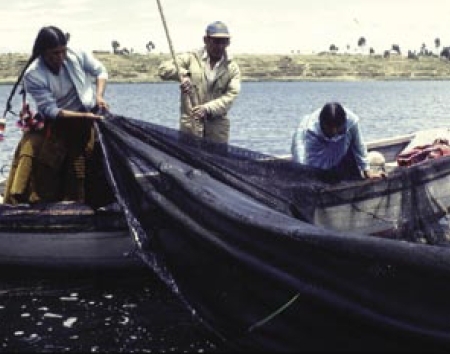
The effective management of inland wetlands and water resources will require improved arrangements for river (or lake or aquifer) basin-scale management and integrated [[coast]al zone] management. Actions taken upstream or upcurrent can have profound impacts on wetland resources downstream or down current. Regional approaches such as IRBM and ICZM are examples of “ecosystem approaches.” Ecosystem approaches have been developed as an overall strategy for integrated environmental management promoting conservation and sustainable use in an equitable way. They focus on managing environmental resources and human needs across landscapes and are a response to the tendency to manage ecosystems for a single good or service, by trying to balance trade-offs to both human well-being and ecosystem services.
An ecosystem approach to water resources management is recognized as a key strategy for meeting the objectives of poverty alleviation. To date, however, few efforts at implementing IRBM have actually succeeded in achieving social, economic, and environmental objectives simultaneously. One of the key lessons emerging from ICZM experiences is that more integration per se does not guarantee better outcomes. Adopting an incremental approach—focusing on a few issues initially and then gradually addressing additional ones as the capacity increases—is often more feasible and effective. In addition, these approaches can only succeed if appropriate institutional and governance arrangements are in place and, in particular, if the authority and resources of the management mechanisms are consistent with their responsibilities.
For international transboundary wetlands, including river systems, lakes, and aquifers, sovereignty is an important issue, making it more challenging to establish a basin-scale organization supported by appropriate governance arrangements. Alternatives such as intergovernmental agreements that mandate development of management arrangements at the basin scale may need to be explored. An important tool for public involvement is the development of a process for transboundary environmental impact assessment.
A key approach for ensuring the future of wetlands and their services is to maintain the quantity and quality of the natural water regimes on which they depend, including the frequency and timing of flows. A variety of methods and tools are available both for assessing the “environmental flow” requirements of wetlands and for implementing, at a basin scale, the range of water allocations to meet policy and planning requirements that balance ecosystem maintenance with public well-being and economic development. These methods and tools provide a means to address the trade-offs for water allocation between different ecosystem services. They can also ensure that sufficient water is allocated to meet multiple objectives agreed to by the wider stakeholder community.
Wetland restoration is a broad response category to recover ecosystems that have been degraded or destroyed. A primary goal of wetland recovery projects is to restore and enhance wetland benefits by re-establishing natural ecological processes. Some wetland functions can be mimicked with engineered structures, but engineered methods typically do not provide the maximum ecological benefit. Restoration has become controversial in part because of the uncertainty about what set of actions leads to the establishment of a desired combination of wetland structure and function. Created wetlands rarely perform the same functions or house the same biodiversity as the original site, and for this reason they are unlikely to structurally and functionally completely replace destroyed wetlands. The key to success is the setting of well-stated goals that form part of a broader comprehensive and rigorous process for planning, developing, implementing, and evaluating the restoration projects and adopting an adaptive management approach.
Systems of protected areas are another important category of response in international, regional, sub-regional, and national frameworks. A regional or landscape approach is necessary especially for aquatic systems, which are not easily “fenced” from surrounding areas. Protected area networks at all levels, including the designation and management of Ramsar sites, play an important role, given the fact that individual sites are often functionally interconnected by reason of shared hydrology, migratory species, and so on.
Although information about the consequences of climate change on specific wetland types and river basins is lacking, it is generally understood that removing the existing pressures on wetlands and improving their resilience is the most effective method of coping with the adverse effects of climate change. Sea level rise, coral bleaching, and changes in hydrology and the temperature of water bodies will lead to a reduction in the goods and services provided by wetlands. Further, efforts to respond to climate change may have equally negative and compounding effects on freshwater and [[coast]al zone] ecosystems. Information about the consequences of climate change on specific wetland types and river basins is sorely needed to allow water resource and wetlands managers to integrate changes in climate into their planning and management efforts. Conserving, maintaining, or rehabilitating wetland ecosystems can be a viable element to an overall climate change mitigation strategy.
Greater coordination of actions among multilateral environmental agreements would result in more-effective implementation. The Ramsar Convention has been promoting cooperation and coordination with other treaties to achieve its objectives. For instance, the Ramsar and World Heritage Conventions have cooperated to identify and strengthen conservation of sites of international importance that are of mutual interest and benefit. Furthermore, cooperation between the Ramsar Convention and the Convention on Migratory Species has been in effect since 1997 in terms of joint conservation action; data collection, storage, and analysis; institutional cooperation; and new agreements on migratory species. The Ramsar Convention is implementing its third joint work plan with the Convention on Biological Diversity, covering the period 2002–06.
Responses addressing direct and indirect drivers and seeking to establish conditions that would be particularly important for biodiversity and ecosystem services include the following:
? Elimination of subsidies that promote excessive use of ecosystem services (and, where possible, transfer of these subsidies to payments for non-marketed ecosystem services). Subsidies paid to the agricultural sectors of OECD countries between 2001 and 2003 averaged over $324 billion annually, or one third the global value of agricultural products in 2000. A significant proportion of this total involved production subsidies that led to overproduction, reduced the profitability of agriculture in developing countries, and promoted overuse of fertilizers and pesticides. Many countries outside the OECD also have inappropriate input and production subsidies. These subsidies could instead be directed to payments to farmers to produce non-marketed ecosystem services through the maintenance of forest cover or wetlands or to protect biodiversity, thereby helping to establish economic incentives to provide these public goods. Similar problems are created by fishery (Fisheries and aquaculture) subsidies, which amounted to approximately $6.2 billion in OECD countries in 2002, or about 20% of the gross value of production. Water use is also often subsidized—for example, by public water supply systems that do not charge consumers for the cost of the water supply infrastructure and maintenance or, as is often the case with groundwater pumping, indirectly through energy subsidies.
Although removal of perverse subsidies will produce net benefits, it will not be without costs. Some of the people benefiting from production subsidies (through either the low prices of products that result from the subsidies or as direct recipients of subsidies) are poor and would be harmed by their removal. Compensatory mechanisms may be needed for these groups. Moreover, removal of agricultural subsidies within the OECD would need to be accompanied by actions designed to minimize adverse impacts on ecosystem services in developing countries.
? Sustainable intensification of agriculture. The expansion of agriculture will continue to be a major driver of wetland loss. In regions where agricultural expansion remains a large threat to wetlands, the development, assessment, and diffusion of technologies that could increase the production of food per unit area sustainably, without harmful trade-offs related to excessive consumption of water or use of nutrients or pesticides, would lessen pressure on wetlands significantly. In many cases, appropriate technologies already exist that could be applied more widely, but countries lack the financial resources and institutional capabilities to gain and use these technologies.
? Slowing and adapting to climate change. By the end of the century, climate change and its impacts may be the dominant direct driver of change of ecosystem services globally. Harm to ecosystems will grow with both increasing rates of change in climate and increasing absolute amounts of change. Some ecosystem services in some regions may initially benefit from increases in temperature or precipitation expected under climate scenarios, but the balance of evidence indicates that there will be a significant net harmful impact on ecosystem services worldwide if global mean surface temperature increases more than 2o Celsius above preindustrial levels or faster than 0.2o Celsius per decade (medium certainty). Given the inertia in the climate system, actions to facilitate the adaptation of biodiversity and ecosystems to climate change will be necessary to mitigate negative impacts. These may include the development of ecological corridors or networks.
? Slowing the global growth in nutrient loading even while increasing fertilizer application in regions where crop yields are constrained by the lack of fertilizers, such as parts of sub-Saharan Africa. Technologies already exist for reducing nutrient pollution at reasonable costs, but new policies are needed for these tools to be applied on a sufficient scale to slow and ultimately reverse the increase in nutrient loading.
? Correction of market failures and internalization of environmental externalities that lead to the degradation of ecosystem services. Because many ecosystem services are not traded in markets, markets fail to provide appropriate signals that might otherwise contribute to the efficient allocation and sustainable use of the services. In addition, many of the harmful trade-offs and costs associated with the management of one ecosystem service are borne by others and so are not weighed in sectoral decisions regarding the management of that service. In countries with supportive institutions in place, market-based tools could be more effectively applied to correct some market failures and internalize externalities, particularly with respect to provisioning ecosystem services.
? Economic interventions, including payments for services and markets, that have long existed for resources such as water that, in many contexts, have long been traded goods. At the same time, water, and the wetlands it supports, has typically been undervalued and consequently underpriced, leading to the inefficient and ineffective management of water for people and ecosystems. Recent efforts have aimed at exploring the potential of water markets as a tool for reallocation of water to meet ecosystem needs as well as the traditional goal of improving resource efficiency for the provision of water to irrigation, hydropower, and drinking water supplies.
? Increased transparency and accountability of government and private-sector performance in decisions that affect wetlands, including greater involvement of concerned stakeholders in decision-making. Laws, policies, institutions, and markets that have been shaped through public participation in decision-making are more likely to be effective and perceived as just. Stakeholder participation also contributes to the decision-making process because it allows for a better understanding of impacts and vulnerability, the distribution of costs and benefits associated with trade-offs, and the identification of a broader range of response options that are available in a specific context. Stakeholder involvement and transparency of decision-making can increase accountability and reduce corruption. Recognition of the importance of public participation and equity in decision-making is growing, and national policies are increasingly being used to support stakeholder participation. Increasing participation at relevant levels supports the concept of subsidiarity—assigning roles and responsibilities at the management level closest to where they will have effect.
Terms of Use
The copyright for material on this page is the property of the World Resources Institute. Click here for the Terms of Use (Ecosystems and Human Well-being: Wetlands and Water: Summary for Decision-makers).
Disclaimer: This chapter is taken wholly from, or contains information that was originally written for the Millennium Ecosystem Assessment as published by the World Resources Institute. The content has not been modified by the Encyclopedia of Earth.
|
|
